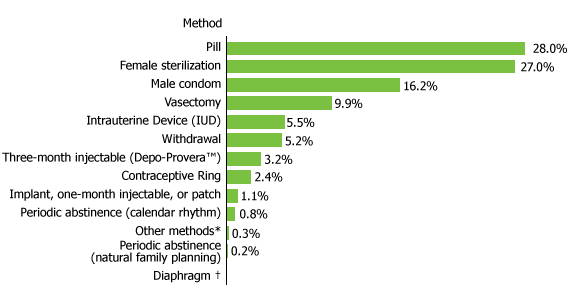Paola Scommegna
Contributing Senior Writer

March 7, 2012
Contributing Senior Writer
The oral contraceptive pill and female sterilization are the most widely used birth control methods in the United States, according to the most recent data available from the U.S. Centers for Disease Control and Prevention (CDC).1 Together, the pill and female sterilization are the choice of more than half of U.S. women ages 15 to 44 who use contraception (see figure). These two methods have been the leading contraceptives in the country since 1982. Male condom, vasectomy, and intrauterine devices (IUD) round out the top five contraceptive methods used.
The 2010 Affordable Care Act requires insurance companies to cover all Food and Drug Administration-approved contraceptive methods and sterilization procedures without co-pays or deductibles beginning August 2012 on new policies.2 Group health plans sponsored by certain religious employers are exempt. These new requirements are expected to have the biggest impact on the use of long-acting reversible methods such as the IUD and implants, which though shown to be extremely effective in preventing pregnancy, have high up-front costs.3
Contraception to control pregnancy is “virtually universal” among women of reproductive age, report demographers William Mosher and Jo Jones of the CDC’s National Center for Health Statistics. Their analysis of the 2006 to 2008 nationally representative National Survey of Family Growth finds that 99 percent of all women who had ever had intercourse had used at least one contraceptive method.4
Among sexually experienced women ages 15 to 44, they find 93 percent had ever had a partner who used the male condom, 82 percent had ever used the oral contraceptive pill, 59 percent had ever had a partner who used withdrawal, and 22 percent had ever used the three-month injectable contraceptive DepoProvera. Nineteen percent of women reported ever using periodic abstinence based on the calendar (rhythm method), while 5 percent reported ever using natural family planning.
 *Includes emergency contraception, female condom or vaginal pouch, foam, cervical cap, Today sponge, suppository or insert, jelly or cream (without diaphragm), and other methods.
*Includes emergency contraception, female condom or vaginal pouch, foam, cervical cap, Today sponge, suppository or insert, jelly or cream (without diaphragm), and other methods.
†Data do not meet standards of reliability or precision.
Source: William D. Mosher and Jo Jones, “Use of Contraception in the United States: 1982–2008,” Vital and Health Statistics 23, no. 29 (2010).
Findings from the CDC report provide a comprehensive picture of U.S. contraceptive use:
Paola Scommegna is a senior writer/editor at the Population Reference Bureau.
